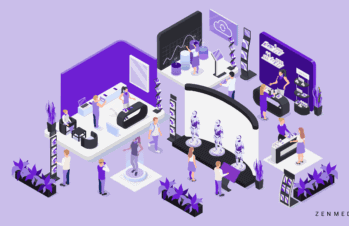This past May, the Forrester B2B Summit North America was held in Austin, Texas. B2B marketing, sales, and product development professionals gathered for four days to immerse themselves in comprehensive sessions with esteemed keynote speakers. The week was packed with marketing insights, groundbreaking research, and opportunities to network and connect with other professionals and leading vendors.
Our very own Stephanie Chavez, President of Zen Media, was in attendance. Here are the top five takeaways from her time at the B2B Summit.
#1: Your Brand Should Be Something People Care About
People show interest in your brand and products when they believe in what you stand for and can remember you. Your purpose, mission, and values are three details that influence employees to stay, partners to invest, and buyers to remain loyal. Core values should always be incorporated into a brand’s look, language, marketing, and customer relations. 64% of consumers who took part in a Harvard Business Review study said that sharing the same values with a brand is the primary reason they have a relationship in the first place.
The most successful businesses have powerful identities that make an impression on people, and it’s their distinct brand values that fuel those identities.
Buyers want to know that they can trust the brands they patronize, not just with their money but also with their time. Your product or service has to match your company’s mission and live up to those expectations.
#2: Actions Speak Louder Than Words
Simply stated: Put your money where your mouth is.
Something that should be completely obvious still costs brands valuable customer relationships and tarnishes their credibility. You can promise to give your audience everything under the sun, but if you don’t back up your words with action, your customer base is as good as gone.
Related reading: It’s Not You, It’s Me: Why Consumers Are Breaking Up With Your Brand
If you make a commitment to a cause or promise an update to solve an existing issue and then fail to deliver, you’re undoing all of the work you put into step #1. You can say all the right things to make your audience care about and support your brand, but if you don’t deliver, your audience will think you’re trying to deceive or take advantage of them.
Buyers will repeatedly support the brands that make an effort to satisfy customers.
Now more than ever, actions speak louder than words. Especially coming out of the thick of the COVID-19 pandemic, people—and even other brands—are searching for solutions and resources to help them get in the swing of our new normal. Part of a brand’s job is to turn a stranger into a trusted friend, and that now demands more than an attractive logo. Adjust your approach to align with what your audience will perceive as valuable and helpful.
Related reading: Here’s How to Build Trust In Your Brand in 2022
#3: Success Metrics Aren’t Always Visible
B2B marketers have been conditioned to believe that the most visible metrics are the ultimate expression of marketing’s value. Sourcing metrics have been prioritized as the best way to understand marketing’s contribution to revenue. However, just because it’s easy to measure doesn’t mean it has any meaningful impact on your marketing strategy.
Related reading: Meaningful > Merely Measurable: Break the CTR Cycle and Bring Real Value
Organizations with an updated vision of what KPIs to actually track will have more meaningful metrics to determine success, which we’ve been talking about for a while.
We’ve said it before, and we’ll say it again: KPIs like click-through rates do not give a comprehensive view into buyer engagement and seller interactions. Sometimes a click is just that—a click.
If you really need metrics to focus on, brand reach and share of voice are the ones that mean something. CTR is easy and convenient to track, but ultimately, it’s a terrible indicator of either digital campaign success or failure.
And the truth is, you can’t measure every aspect of your strategy, but that doesn’t mean it’s not working.
#4: Consumers Come First, Then the Ads
Customer marketing refers to any marketing activity focused on leveraging and elevating current customer experiences. These efforts are specifically designed to drive retention, loyalty, advocacy, and growth.
To ensure your advertising efforts aren’t wasted, you must know what people want to see. Otherwise, you may put time and resources into something no one cares about. When it comes to B2B buyers, marketers have to understand their audience’s unique needs and behaviors if they want to minimize advertising waste. Making decisions from the customer’s perspective allows your team to cater their strategy to specific audience segments and then track how engaged your targeted audiences are with the materials you produce.
The more you know about your audiences the more you can personalize your paid ads, but always factor in blind spots and some level of advertisement waste. Consumers may provide false personal information or block website cookies, preventing the collection of accurate traffic data for your ads.
Our recommendation—if you want to know what your customers want, ask them.
#5: Your Content Must Evolve for The Future
Content has always been a core component of the consumer experience. Some form of content is what most likely drew them to your brand in the first place. However, the job content is doing right now is not up to par with the experience consumers expect to have. Most companies’ content engines are too formulaic and siloed, and they cannot provide buyers what need in the heat of the moment—unless content evolves.
Content will never get old because there will always be an audience for it. It’s a continuous process of creating, publishing, sharing, distributing, and planning, with the ultimate goal of building a connection between your brand and your audience. People invest time when the topic interests them, so marketers have to make B2B content so captivating that buyers can’t resist immersing themselves. Whether you choose the written form or video, social media or blogging, newsletters or case studies—it’s time for content marketers to step up their game and really consider what type of content their prospects and buyers are looking for.
If you’ve been paying attention, you’ve probably noted one central theme in these takeaways: the buyer’s perspective. The future of B2B marketing is centralized on service. How can you best serve the decision-makers in your target audience? The answer is what should lead your strategy into the future.
Need help targeting your audience and figuring out what they want? Let’s talk.









